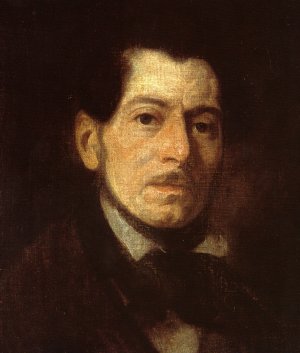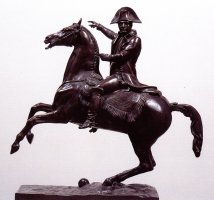|

Piotr Michałowski
1800-1855 |
|

Self portrait, Piotr Michalowski
Oil on canvas, 54 x 45 cm, post 1849 National Museum in Warsaw
|
|
The son of a Senator of the Free City of Krakow where he was born, Piotr Michalowski (1800-55) is a principal exponent of Romanticism in Polish painting. At the age of nine he witnessed the entry into Krakow of Prince Jozef Poniatowski at the head of the Polish Napoleonic Army (Krakow had been up to that time part of the Austrian partition. On the other hand, Jozef Poniatowsk, the nephew of Poland's last King, was the Commander in Chief of the Polish Army of the Duchy of Warsaw, a entity created by Napoleon out of lands of the German partition. His entry into Krakow symbolized its liberation from Austrian rule).
He studied natural sciences, economics and the arts at the Universities of Krakow (1815-20) and Göttingen (1821-23). In the years 1923-30 he was a member of the Governmental Income and Treasury Commission in Warsaw, at that time capital of so called Kingdom of Poland (somewhat autonomous but with the Russian Tsar as its King), wherein he was charged with the development of steelworks. During the November Uprising of 1830, he was in charge of the manufacture of firearms and ammunition. With the 1832 suppression of the Uprising by Russia, he was forced to choose exile in France.
As an amateur, a period that lasted until 1832, he had primarily made sketches and watercolors, influenced by Orlowski and Verneta. In Paris, he studied in the atelier of Charlet as well as in musea where he paid particular attention to painter of the Spanish ( viz.: Velazquez), Dutch and Flemish

Portrait of peasant with hat
Piotr Michalowski
Oil on canvas, 52,7 x 35,5 cm,
post 1846 National Museum in Warsaw
|
|
schools (in his studies of the anatomy of the horse is evident the influence of Gericault). During 1935 he sojourned in Great Britain after which he returned to Krakow. In 1815, at the post Napoleonic Congress of Vienna had become the Free City of Krakow, gaining thereby significant autonomy from the Austrian Empire. He resided either in Krakow or on the estates of his family which he administered. He made frequent visits to
France and during various periods of his life also visited Belgium, the Czech lands, Germany, Switzerland and Italy. As a consequence of the Free City's role in an unsuccessful 1848 uprising in the Austrian partition during the Spring of Nations , the status of Free City was liquidated and Krakow again becoming and integral part of the Austrian partition. It was then that Michalowski became the President of the Administrative Council of the town and its surroundings (1848-53) and, subsequently, following abolition of the Council by the Austrian authorities, the President of the Krakow Association of Landowners. In this period he developed fully his art and, during frequent trips abroad, he continued his studies in musea.
Michalowski was particularly given to the drawings and paintings (in oil and watercolors) of horses, horse drawn vehicles and cattle. He created Napoleonic battle scenes, including several of the Somosierra battle, full of movement. Likewise he painted battle scenes form the November Uprising.. He was fascinated by Napoleon of whom he painted many mounted portraits alsoundertook a project for a mounted statue of him. He also

Napoleon on horseback
Piotr Michalowski
Bronze, 1832-35, cast 1841 National Museum in Krakow
|
|
painted mounted portraits of Polish military leaders, for instance Czarniecki and Kniaziewicz. He created realistic yet fully expressive portraits of members of his family, particularly children, and of his friends. He also painted studies of the peasant faces (Senko 1846-48). Skilled in the use of color, his compositions are characterized by excellent bold design and freedom in the use of painting techniques - he used long brush strokes. Michalowski's paintings reveal the force of his poetic feelings for nature and man, and the dynamism and fervor of a romantic patriot.
Piotr Michalowski was also a sculptor, although only a few of his sculptures have survived. In the years 1832-1835 while living in Paris, he created a plaster model for an equestrian statue of Napoleon Bonaparte which was to stand in Cour Carre of the Louvre. Although the work of the Polish artist was praised by Marshal Soult and General Fabvier, the statue didn't get erected. However, using the artist's plaster model, a number of statuettes were cast in bronze in 1840 and one of them is in the collection of the National Museum in Krakow. |

The Krakowians' skirmish of and study of a horse, Piotr Michalowski
Oil on canvas, ca 1830 National Museum in Poznan
|
Michałowski's painting constitutes a romantic vision of a battle scene and an echo of the events of the November uprising of 1830. The rusty dustcloud of battle, the glistening silhouettes of several galloping riders, the white peasant coats, the purplish four-cornered Krakowian hats, the glint of the lances, the impetus of the attack scattering the enemy, all characterize the dynamism of the composition. That dynamism has been contrasted with the study of the horse in the foreground, matter of fact and intense. The restrained characterization of the beautiful animal brings about a moment of reflection, unexpected in this context. The horse appears to have be witness to events contrary to its nature. The connection on a single canvas of the mortal battle and the study of a horse was not the artist's original intention. Michałowski began to sketch the battle, but it didn't take up the whole canvas and so he could, changing his intentions, sketch the study of a horse - a motif which always fascinated him. The juxtaposition of the Krakowians' skirmish and the figure of the animal created an entity of a new kind, without evident incoherence.
|
Note: The last paragraph on this page is an English language version of a Polish language analysis by Adam Beim which can be accessed by clicking on the image. This information may include copyrighted material and is to be used for educational and research purposes only. | |
| | | |
|
